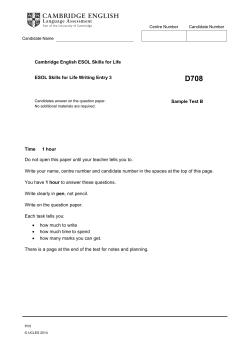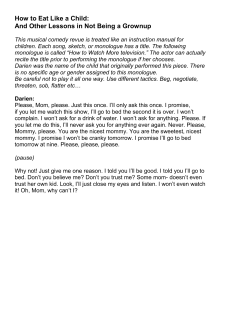
Creeping Charlie (Glechoma hederacea)
Weed Identification and Control Sheet: Creeping Charlie (Glechoma hederacea) www.goodoak.com/weeds DESCRIPTION: Also known as ground ivy or gill-over-the-ground, creeping Charlie is a troublesome lawn pest, especially in damp and shaded areas, which can spread into planting beds and natural areas as well. This species is commonly vilified because it is difficult to control without damaging surround vegetation. This herbaceous vine spreads along the ground in low vegetation (such as lawns) often sending down roots at nodes where leaves sprout. Short flower stalks will form in unmowed areas, especially during the mid-spring flowering season, but the plants are never more than 8 inches tall. Leaves are heart or kidney shaped with rounded teeth along the margin. These leaves are arranged opposite to each other on the stems, which are square in cross-section. When present the flowers are small, purple and tubular with a large lower lip. Creeping Charlie has a strong minty scent which is unmistakable once you become familiar with it. CONTROL METHODS: Organic: Controlling the creeping Charlie vine when they are the young, first-year stems is critical to success. These young creeping vines do not have significant roots, so they can be easily pulled or raked. To control older portions of the plant by hand you will have to follow the stems to each root node and carefully dig out the small roots; an extremely tedious process. If you simply rip away the viney stem and leaves will leave the roots in place and they will vigorously resprout. This method will need to be repeated, since you will undoubtedly miss some root fragments, but persistence will be rewarded with success. A very low mowing to the ground repeated as the plants resprout, may be a good way to initiate creeping Charlie control, but hand weeding or chemical application will be needed to complete the process. Treating creeping Charlie with a solution of borax in water (30 parts water to 1 part borax) is often effective. This can cause some damage to grass, but overall the grass fairs better than does the creeping Charlie. This method should not be used if creeping Charlie is invaded among other perennials since they may be damaged as well. Also note that this “organic” treatment may not be much, if any, safer than herbicide treatments since borax can be toxic at high concentrations. For naturalized areas a prescribed fire is very effective at controlling this shallowly-rooted species. Flame weeding with a propane torch has also proven successful where this method can be successfully applied (NOT in areas with a lot of dead, dry plant material). In natural areas, vigorous competition from desired plants is one of the most important aspects of creeping Charlie control. Chemical: Foliar application of glyphosate (Round-up®, etc.) will kill this and every other plant in areas where there is little other desirable vegetation. Broadleaf specific herbicides which contain triclopyr or dicamba (usually in addition to 2,4-D) will not kill grass and can be used in lawn situations. Some examples include Weed-Be-Gon® and Ortho® Lawn Weed Killer. Herbicide applications are most effective in early fall, from September through October but can also be applied from May through early June. Two applications of herbicide, 2 weeks apart, may be needed for complete control. Always read herbicide labels carefully before use and always apply according to the instruction on the product label. NATIVE ALTERNATIVES: Creeping Charlie is not a species people are looking to replace; usually the goal is simply removal. However, some of our more aggressive woodland ground covers such as Virginia Waterleaf (Hydrophyllum virginianum), Wild Ginger (Asarum canadense), wild strawberry (Fragaria virginiana) or woodland strawberry (F. vesca) should provide some worthy competition, while providing food and shelter to native wildlife. All content © Frank Hassler 2015, unless otherwise noted. Updated: 4/21/15
© Copyright 2025










